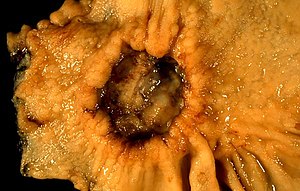Gastric adenocarcinoma
| Stomach cancer | |
|---|---|
 |
|
| A stomach ulcer that was diagnosed as cancer on biopsy and surgically removed. | |
| Classification and external resources | |
| Specialty | Oncology |
| ICD-10 | C16 |
| ICD-9-CM | 151 |
| OMIM | 137215 |
| DiseasesDB | 12445 |
| MedlinePlus | 000223 |
| eMedicine | med/845 |
| MeSH | D013274 |
| GeneReviews | |
Stomach cancer, also known as gastric cancer, is cancer developing from the lining of the stomach. Early symptoms may include heartburn, upper abdominal pain, nausea and loss of appetite. Later signs and symptoms may include weight loss, yellowing of the skin and whites of the eyes, vomiting, difficulty swallowing, and blood in the stool among others. The cancer may spread from the stomach to other parts of the body, particularly the liver, lungs, bones, lining of the abdomen and lymph nodes.
The most common cause is infection by the bacterium Helicobacter pylori, which accounts for more than 60% of cases. Certain types of H. pylori have greater risks than others. Other common causes include eating pickled vegetables and smoking. About 10% of cases run in families and between 1% and 3% of cases are due to genetic syndromes inherited from a person's parents such as hereditary diffuse gastric cancer. Most cases of stomach cancers are gastric carcinomas. This type can be divided into a number of subtypes. Lymphomas and mesenchymal tumors may also develop in the stomach. Most of the time, stomach cancer develops in stages over years. Diagnosis is usually by biopsy done during endoscopy. This is followed by medical imaging to determine if the disease has spread to other parts of the body.Japan and South Korea, two countries that have high rates of the disease, screen for stomach cancer.
...
Wikipedia
